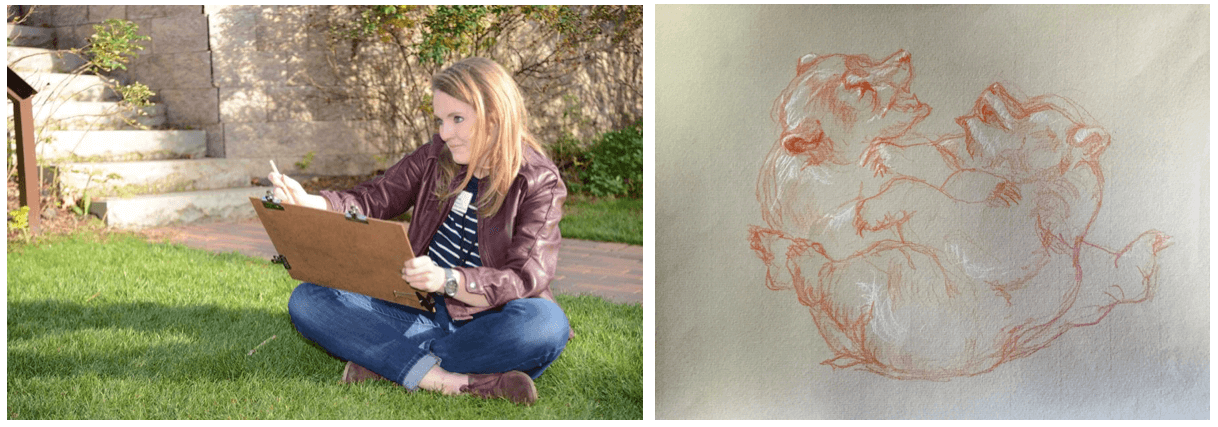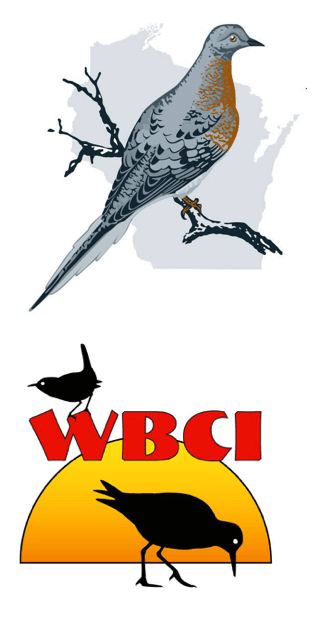Artist residencies enliven artwork on view for Woodson Art Museum visitors, area students, and program participants. Working with guest artists also prompts Museum staff to re-engage and reconsider an exhibition. Otherwise, quite frankly, we’ve moved on to planning and preparing for the next exhibitions. Changing exhibitions remain on view about twelve weeks, so staff has enough time to become well acquainted with artwork but insufficient time to rest on our laurels or delay diving into the logistics, content, and interpretive planning for upcoming exhibitions.
An artist in residence, however, invites us to revisit artwork on view through their presentations and guidance during programs and workshops. I’ve had the pleasure of working with two Birds in Art artists so far this fall – Sean Murtha and Timothy David Mayhew – and am looking forward to the third residency with sculptor Gene Reineking.
Working on toned paper with charcoal drawing pencils, Sean Murtha encouraged me and hundreds of students, October 4-8, to closely observe value (the range of light to dark in a work), proportion and scale (my biggest challenge!), and ways to develop form (the appearance of three-dimensional mass in two-dimensions) in our sketches.
Timothy David Mayhew introduced me and many others to the working properties of natural chalks and metalpoint and instructed workshop participants in the nuances of how incredibly faint lines, created using an artist-made reed holder, should give way to layers of hatching, which establish volume in our drawings. During the last portion of the workshop, we had an opportunity to go outside – with drawing boards, chalk, and toned paper in hand – to sketch sculpture on the Museum’s grounds. Working quickly and lightly, I mapped out a favorite sculpture of mine – Dan Ostermiller’s Boys Will Be Boys.

Without these artist-residency experiences, I might miss the opportunity to carefully examine a sculpture I admire. Or I could miss the opportunity to appreciate (more like envy?) the discipline, passion, and skill of artists featured in the galleries if I hadn’t participated and tried my own hand using some of these materials and techniques.
As much fun as it is to wander as a novice through a world of studio art materials, I find equal pleasure in learning from the scientific minds who flock to the Museum to share their experiences and expertise during Birds in Art. Working with ecologists, authors, biologists, and conservationists reignites my interest in the subjects featured in artwork on view and allows me to view the Woodson Art Museum’s flagship exhibition with fresh eyes yet again.
 On Saturday afternoon, Museum education staff presented “Images and Application: Teaching Conservation through Art” at the Bird City Wisconsin Summit and Wisconsin Bird Conservation Initiative Annual Conference, which focused on “Protecting Birds through Action and Art.” Lisa Hoffman, Shannon Pueschner, and I shared ideas, artworks, and hands-on-art-making exercises with a room full of avian enthusiasts who agreed the arts can serve as a gateway to environmental connectedness and stewardship. I’m grateful to all the attendees who work tirelessly on behalf of birds and their environments, and I admire those who developed the conference, electing to make an explicit connection between the fields of art and science.
On Saturday afternoon, Museum education staff presented “Images and Application: Teaching Conservation through Art” at the Bird City Wisconsin Summit and Wisconsin Bird Conservation Initiative Annual Conference, which focused on “Protecting Birds through Action and Art.” Lisa Hoffman, Shannon Pueschner, and I shared ideas, artworks, and hands-on-art-making exercises with a room full of avian enthusiasts who agreed the arts can serve as a gateway to environmental connectedness and stewardship. I’m grateful to all the attendees who work tirelessly on behalf of birds and their environments, and I admire those who developed the conference, electing to make an explicit connection between the fields of art and science.
I see these fields as closely related, each endeavoring to foster greater understanding and appreciation of our world through observation, exploration, and active investigation.
This week at the Museum offers an additional opportunity to ponder the ecology of the avian world during Alan Haney and Eric Anderson’s Art 101 talk, Thursday, November 3, 5:30-6:30 pm. I know you’ll learn a lot and likely re-engage with this year’s Birds in Art exhibition from a different perspective.
I hope Woodson Art Museum visitors and loyal Birds in Art devotees will be similarly encouraged to consider artwork anew via a variety of contexts and educational experiences.
What recent Birds in Art experience inspired you?




